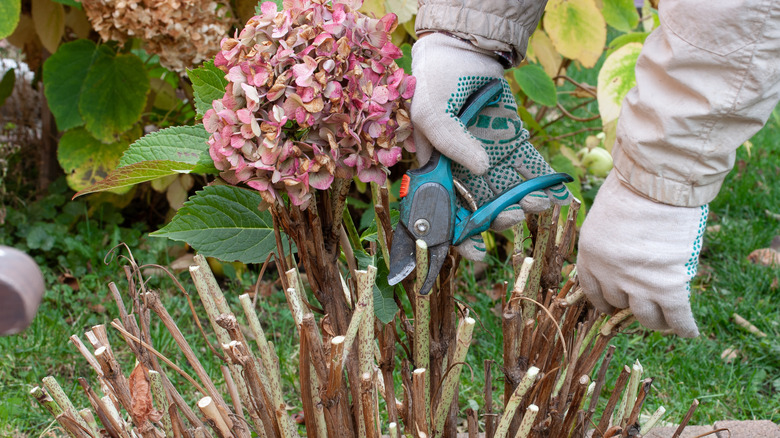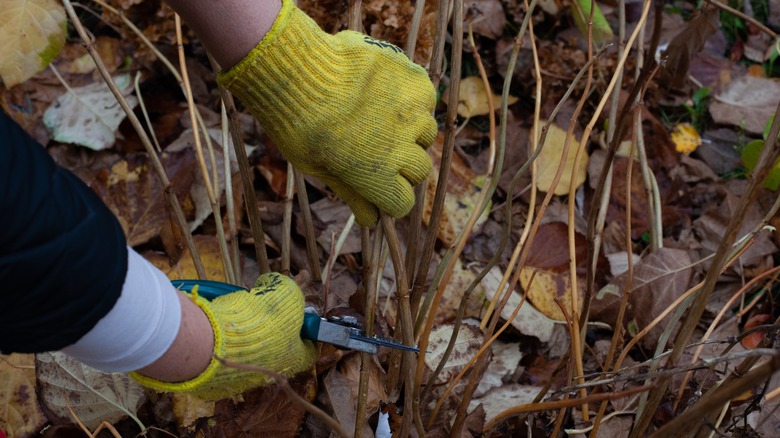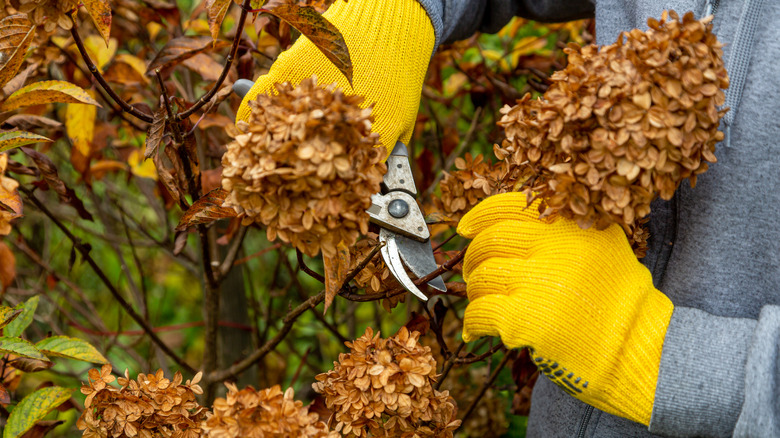Should You Cut Your Hydrangeas Back In The Fall?
The first rule about cutting back hydrangeas is to only do it when absolutely necessary. HGTV points out that deadheading blossoms and light pruning to clear away dead branches are always beneficial, but otherwise your hydrangea bushes will do fine left to their own devices.
Of course, sometimes we all need to tame an overgrown shrub; in the case of a wayward hydrangea, move on to rule No. 2. The second rule about cutting back hydrangeas is to know your shrub. Being able to name the species or type is great, but when it comes to fall pruning, what you really need to know is whether your hydrangea blossoms on new or old wood.
Per Here By Design, early-season bloomers (before July) are flowering on old wood from the previous season. These include the bigleaf, mophead, lacecap, and oakleaf varieties. They shouldn't be cut back in the fall because it would inhibit the next season's growth — you'd essentially be cutting off the flower buds.
Think of it this way: Cutting back wood in the fall equals fewer flowers come spring. When an old wood hydrangea does require pruning, it should be done at a minimum and immediately after the flowers stop blossoming during summer. Here By Designs says this can happen up until July at the latest. Guidelines are different for new wood hydrangeas. And what do you do if you're not sure either way? Keep reading.
How do you cut back new wood hydrangeas in the fall?
If your garden is home to a late-season bloomer (flowers appearing after July), then you have a new wood hydrangea, such as the PeeGee and Annabelle (sometimes called smooth) varieties. These bushes set buds on new growth from the current season and, according to the University of California Cooperative Extension, they are the hydrangeas that are okay to cut back in the fall. The reason it's safe to do so is that the new growth with the new season's flowers will come from the base of the plant, notes Here By Design.
Start by deadheading in late summer, then as fall arrives, cut back the oldest branches. Once the season ends, you can go ahead with more severe pruning. If you feel the need, you can cut the plant all the way to ground level, but over time, that won't be the best approach, as it will likely weaken the stems.
Of course, there's an exception to the rule. Endless blooming or summer varieties are the hydrangeas that just don't quit. These bushes blossom on old wood early in the season and then do it again on the new wood growth in late summer. The University of California Cooperative Extension says to prune them lightly in the fall, but only to maintain their shape.
What if I don't know what kind of hydrangea I have?
Perhaps you're clueless about whether you have new or old wood hydrangeas. If that's the case, don't cut them back in the fall. Instead, the University of Maryland Extension advises adhering to a limited pruning plan for all of your bushes.
Once a year during spring, clear away any obvious dead or decaying branches. For any you're unsure about, use a sharp knife to pare back a small section of bark. You're looking for fresh green growth underneath; if it's not there, the branch is dead and can be cut back all the way down to the base.
After your hydrangeas bloom throughout spring and summer, take a walk through your garden and deadhead the flowers as they dry out and their color fades to brown. Millcreek Gardens points out this is rather easy to do and makes a positive difference to a plant's overall health.
With a set of clean, sharp shears, make each cut a few inches down the stem at the first set of leaves. Bring a bucket with you to collect the spent blooms and be sure to stop this practice around the middle of fall. At that point, any remaining blooms can stay on the bushes until they naturally fall on their own.


